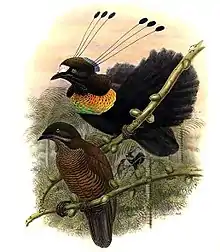Parotia
The parotias are a genus, Parotia, of passerine birds in the bird-of-paradise family Paradisaeidae. They are endemic to New Guinea. They are also known as six-plumed birds of paradise, due to their six head quills. These birds were featured prominently in the BBC series Planet Earth.
| Parotia | |
|---|---|
 | |
| Lawes's parotia, Parotia lawesii Male above, female below | |
| Scientific classification | |
| Domain: | Eukaryota |
| Kingdom: | Animalia |
| Phylum: | Chordata |
| Clade: | Dinosauria |
| Class: | Aves |
| Order: | Passeriformes |
| Family: | Paradisaeidae |
| Genus: | Parotia Vieillot, 1816 |
| Type species | |
| Paradisea sefilata[1] J.R. Forster, 1781 | |
| Species | |
|
6; see text. | |
The males of the genus are characterized by an ornamental plumage consisting of six wired head plumes with black oval-shaped tips, a neck collar of black, decomposed feathers which can be spread into a skirt-like shape, and bright or iridescent head and throat markings. During courtship, they perform ballerina-like dances and spread out their "skirt" on a patch of forest floor they have meticulously cleaned of dead leaves and other debris.[2] The "ballerina dances" usually consist of the male hopping from foot and bobbing their heads from side to side. The males are polygamous and do not take part in raising the young. Clutch size is somewhat uncertain; it is usually one to three eggs.[3]
Taxonomy
The genus name is composed of par, meaning "near" and Ancient Greek ωτος ōtos for "ear", specifically meaning "curl of hair by the ear", referring to six head plumes on each side of the head, characteristic to male birds of this genus.[4]
Species
- Western parotia, Parotia sefilata
- Carola's parotia, Parotia carolae
- Bronze parotia, Parotia berlepschi
- Lawes's parotia, Parotia lawesii
- Eastern parotia, Parotia helenae
- Wahnes's parotia, Parotia wahnesi
References
- "Paradisaeidae". aviansystematics.org. The Trust for Avian Systematics. Retrieved 2023-07-16.
- Scholes, 2008
- Mackay, 1990
- Schodde, Richard (July 2010). "Handbook of the Birds of the World, vol. 14: Bush-shrikes to Old World Sparrows.— Josep del Hoyo , Andrew Elliott , and David Christie , Eds. 2009. Lynx Edicions, Barcelona, Spain. 893 pp., 51 color plates, 655 color photos, 484 distribution maps. ISBN 9788496553507. Cloth binding. $267.00". The Auk. 127 (3): 714–717. doi:10.1525/auk.2010.127.3.714. ISSN 0004-8038. S2CID 198155470.
- Mackay, Margaret D. (1990): The Egg of Wahnes' Parotia Parotia wahnesi (Paradisaeidae). Emu 90(4): 269.
- Scholes III, Edwin (2008): Evolution of the courtship phenotype in the bird of paradise genus Parotia (Aves: Paradisaeidae): homology, phylogeny, and modularity. Biological Journal of the Linnean Society 94: 491–504.